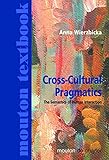Cross-Cultural Pragmatics : The Semantics of Human Interaction / Anna Wierzbicka.
Material type: TextSeries: Mouton TextbookPublisher: Berlin ; Boston : De Gruyter Mouton, [2009]Copyright date: ©2003Edition: 2nd ed. [with a new preface] 2003Description: 1 online resource (502 p.)Content type:
TextSeries: Mouton TextbookPublisher: Berlin ; Boston : De Gruyter Mouton, [2009]Copyright date: ©2003Edition: 2nd ed. [with a new preface] 2003Description: 1 online resource (502 p.)Content type: - 9783110220964
- 306.44 21
- P99.4.P72 W53 2003eb
- online - DeGruyter
| Item type | Current library | Call number | URL | Status | Notes | Barcode | |
|---|---|---|---|---|---|---|---|
 eBook
eBook
|
Biblioteca "Angelicum" Pont. Univ. S.Tommaso d'Aquino Nuvola online | online - DeGruyter (Browse shelf(Opens below)) | Online access | Not for loan (Accesso limitato) | Accesso per gli utenti autorizzati / Access for authorized users | (dgr)9783110220964 |
Browsing Biblioteca "Angelicum" Pont. Univ. S.Tommaso d'Aquino shelves, Shelving location: Nuvola online Close shelf browser (Hides shelf browser)

|

|

|

|

|

|

|
||
| online - DeGruyter Deutschsprachige Artusdichtung des Mittelalters : Eine Einführung / | online - DeGruyter Rethinking Universals : How Rarities Affect Linguistic Theory / | online - DeGruyter The Native Speaker Concept : Ethnographic Investigations of Native Speaker Effects / | online - DeGruyter Cross-Cultural Pragmatics : The Semantics of Human Interaction / | online - DeGruyter The Collected Works of Bronislaw Pilsudski. Volume 4, Materials for the Study of Tungusic Languages and Folklore / | online - DeGruyter Kierkegaard und Fichte : Praktische und religiöse Subjektivität / | online - DeGruyter Praktische Theologie / |
restricted access online access with authorization star
http://purl.org/coar/access_right/c_16ec
This book, which can be seen as both a research monograph and a text book, challenges the approaches to human interaction based on supposedly universal "maxims of conversation" and "principles of politeness", which fly in the face of reality as experienced by millions of people - refugees, immigrants, crosscultural families, and so on. By contrast to such approaches, which can be of no use in crosscultural communication and education, this book is both theoretical and practical: it shows that in different societies, norms of human interaction are different and reflect different cultural attitudes and values; and it offers a framework within which different cultural norms and different ways of speaking can be effectively explored, explained, and taught. The book discusses data from a wide range of languages, including English, Italian, Russian, Polish, Yiddish, Hebrew, Japanese, Korean, and Walmatjari (an Australian Aboriginal language), and it shows that the meanings expressed in human interaction and the different "cultural scripts" prevailing in different speech communities can be described and compared in a way that is clear, simple, rigorous, and free of ethnocentric bias by using a "natural semantic metalanguage", based on empirically established universal human concepts. As the book shows, this metalanguage can be used as a basis for teaching successful cross-cultural communication and education, including the teaching of languages in a cultural context.
Mode of access: Internet via World Wide Web.
In English.
Description based on online resource; title from PDF title page (publisher's Web site, viewed 17. Dez 2021)


